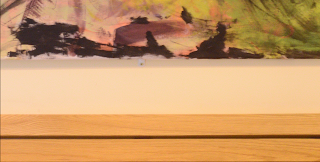Landscape with deep DOF
f/16 - 1/80 secs. - ISO 100
For my landscape shot I figured that with snow a lower vantage point would be the best choice for this shot. With my 50mm lens, because it was all I had on me at the time, the smallest aperture I could obtain was f/16. I didn't have any idea in particular for shooting my landscape shot, all as long as everything was in focus and sharp, and that what I'm shooting is decent-looking, I was very satisfied with this.
Night scene
f/5.6 - 2.5" - ISO 100
For my night scene photograph, as I was reading the assignment I saw "ghosted elements and light trails" and this was the first thing I thought of. In the "Instagram" world this is what we call "fire-painting", you light up some steel wool, attach it to something and start "whipping it" around. All depending on what shape exactly you want to capture. In my case, we tried an 8 sideways (infinite sign basically), a regular circle from the top, on the side and also from the front. I had to play a lot mostly with my shutter speed because I either had too many light trails in my picture or not quite enough, in the end this was one of my best shots that I am more than satisfied with. The person in the image is still visible but isn't exactly sharp and on focused, it seems more ghosted than anything else, another reason why I liked this image a lot, I have a mix of both ghosting & light trails.
Portrait with shallow DOF
f/1.8 - 1/125 secs. - ISO 800
For this portrait I just wanted to make something simple. No huge set, makeup or anything. Just my subject and a satisfying background. I chose the kitchen because the lighting was good and also because he likes spending time in the kitchen (he likes cooking) so I told myself, why not have him in an environment he likes? Focusing on his eyes was what mattered the most for me.
Shooting a sport
f/8 - 1/150 secs. - ISO 800
This is probably not the most ideal sport shot but here's an acquaintance of mine sort of climbing//jumping around. In this shot more precisely, if I remember it well, he was just about to jump on another platform (I honestly don't know what it is). Initially, I wanted him to do a few flips around the place and have a shot of him in the air as he does his stunts, but because of the weather conditions that day I preferred not making him do that, he also preferred climbing around so I didn't stop him from doing so either, When our teacher gave this as apart of our assignment, I knew that going to an actual sporting event wasn't going to be easy because I don't have the right equipment nor an can I get very close to my subject. So I came up with this idea and it worked out pretty well in the end.






















































